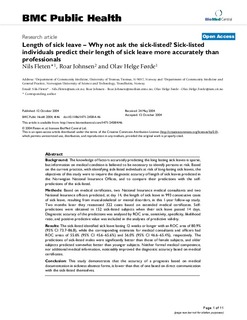| dc.description.abstract | Background:
The knowledge of factors accurately predicting the long lasting sick leaves is sparse, but information on medical condition is believed to be necessary to identify persons at risk. Based on the current practice, with identifying sick-listed individuals at risk of long-lasting sick leaves, the objectives of this study were to inquire the diagnostic accuracy of length of sick leaves predicted in the Norwegian National Insurance Offices, and to compare their predictions with the self-predictions of the sick-listed.
Methods:
Based on medical certificates, two National Insurance medical consultants and two National Insurance officers predicted, at day 14, the length of sick leave in 993 consecutive cases of sick leave, resulting from musculoskeletal or mental disorders, in this 1-year follow-up study. Two months later they reassessed 322 cases based on extended medical certificates. Self-predictions were obtained in 152 sick-listed subjects when their sick leave passed 14 days. Diagnostic accuracy of the predictions was analysed by ROC area, sensitivity, specificity, likelihood ratio, and positive predictive value was included in the analyses of predictive validity.
Results:
The sick-listed identified sick leave lasting 12 weeks or longer with an ROC area of 80.9% (95% CI 73.7–86.8), while the corresponding estimates for medical consultants and officers had ROC areas of 55.6% (95% CI 45.6–65.6%) and 56.0% (95% CI 46.6–65.4%), respectively. The predictions of sick-listed males were significantly better than those of female subjects, and older subjects predicted somewhat better than younger subjects. Neither formal medical competence, nor additional medical information, noticeably improved the diagnostic accuracy based on medical certificates.
Conclusion:
This study demonstrates that the accuracy of a prognosis based on medical documentation in sickness absence forms, is lower than that of one based on direct communication with the sick-listed themselves. | nb_NO |
